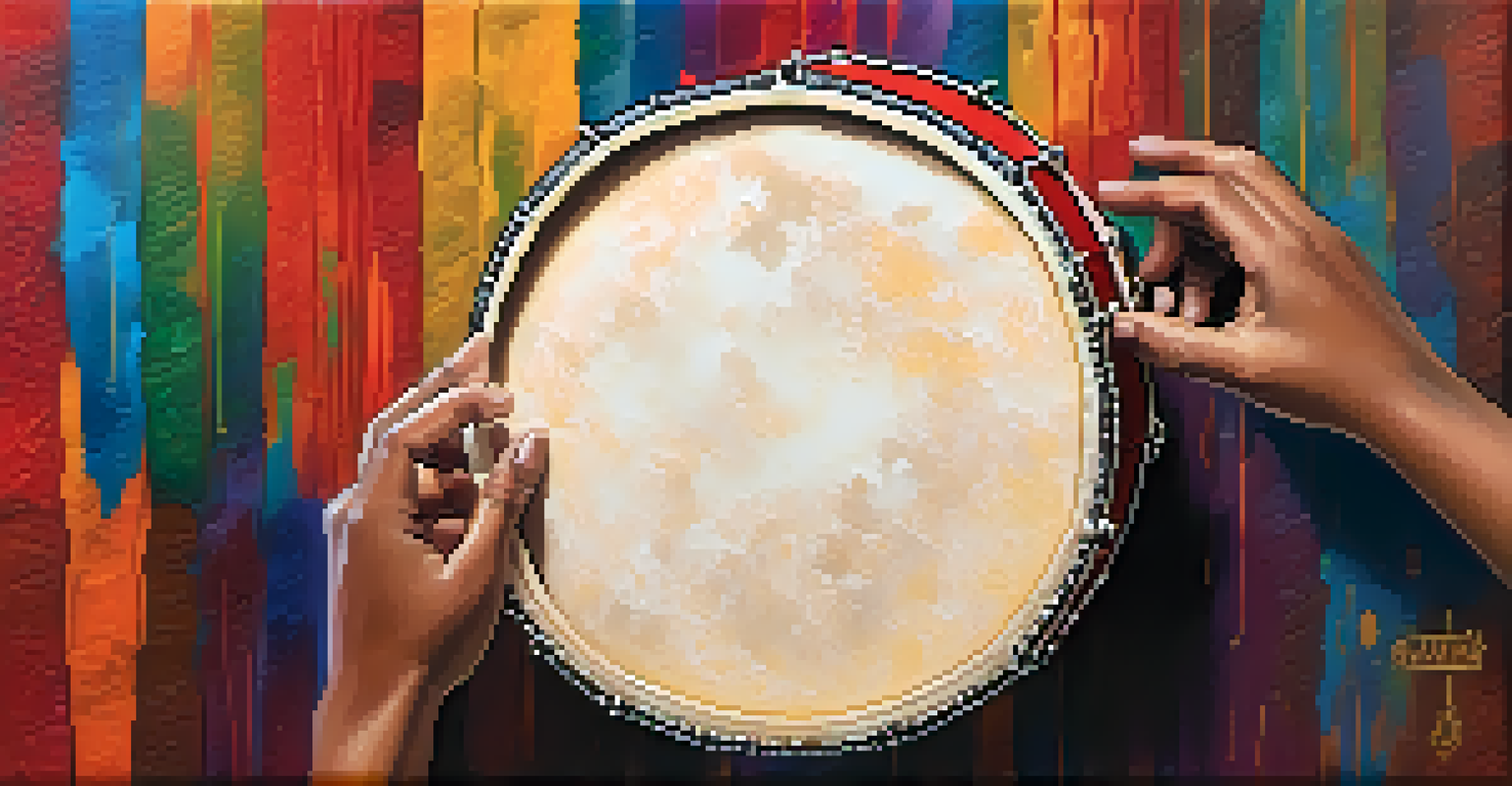Music Therapy: Healing Through Identity and Cultural Connection

Understanding Music Therapy and Its Healing Power
Music therapy is a therapeutic approach that uses music to address physical, emotional, cognitive, and social needs. It's more than just listening to melodies; it's about harnessing the power of sound to foster healing. As a structured process, music therapy often involves creating, singing, playing instruments, and listening to music, tailored to individuals' specific needs.
Music can change the world because it can change people.
One of the key elements of music therapy is its ability to evoke emotions and memories, making it a powerful tool for healing. For instance, a person suffering from trauma may find solace in a song that reminds them of happier times, while someone with anxiety may benefit from calming melodies. This emotional connection to music can open doors to self-expression and exploration.
Ultimately, music therapy serves as a bridge between the mind and body, allowing individuals to process their feelings in a safe space. This holistic approach not only promotes healing but also encourages personal growth, making it a valuable resource for many individuals seeking to overcome challenges.
The Role of Identity in Music Therapy
Identity plays a crucial role in music therapy, as it shapes how individuals relate to music and what it means to them. Personal experiences, cultural backgrounds, and societal influences all contribute to one's musical identity. This means that a therapist must consider these factors when designing a music therapy session.

For example, someone who identifies strongly with their cultural heritage may find healing through traditional songs and instruments from their background. Engaging with familiar music can evoke a sense of belonging, helping individuals reconnect with their roots and sense of self. This cultural connection can be incredibly empowering, especially for those feeling lost or disconnected.
Music Therapy's Healing Power
Music therapy harnesses the power of sound to address emotional, physical, and social needs, promoting healing and personal growth.
By integrating an individual's identity into the therapeutic process, music therapy becomes a personalized journey. It fosters a sense of agency, allowing clients to express themselves authentically. This recognition of identity not only enhances the therapeutic experience but also makes the healing process more impactful.
Cultural Connections Through Music Therapy
Cultural connections are a vital aspect of music therapy, as they enable individuals to explore and celebrate their heritage. Music often serves as a reflection of cultural identity, allowing clients to engage with their roots in a meaningful way. This connection can be particularly beneficial for those from marginalized communities seeking to reclaim their cultural narratives.
Where words fail, music speaks.
For instance, a music therapy session might include traditional songs from a client's culture, facilitating a dialogue about their experiences and feelings. This not only validates their identity but also reinforces the importance of their cultural background in the healing process. It creates a safe environment for clients to share their stories and connect with others who may have similar experiences.
Moreover, engaging with diverse musical traditions can broaden perspectives and foster empathy among clients. By sharing and exploring different cultural expressions, individuals can find common ground and strengthen their sense of community. This cultural exchange enriches the therapeutic experience, creating a tapestry of healing through the universal language of music.
The Therapeutic Process: Techniques and Approaches
Music therapists employ various techniques to facilitate healing, tailored to each client's unique needs. Some common approaches include improvisation, songwriting, and guided imagery with music. These methods encourage clients to express themselves creatively, often leading to breakthroughs in their emotional and psychological well-being.
For instance, improvisation allows clients to create music spontaneously, which can be particularly liberating for those struggling to verbalize their feelings. By playing instruments or singing, they can explore their emotions in a non-threatening way. This playful interaction with music can lead to greater self-awareness and personal insights.
Cultural Identity in Healing
Integrating an individual's cultural identity into music therapy enhances the therapeutic experience and fosters a sense of belonging.
Songwriting, on the other hand, enables clients to articulate their experiences and emotions through lyrics. This process can be therapeutic, as it encourages reflection and exploration of feelings. By combining these techniques, music therapy becomes a dynamic and adaptable process that empowers clients to take charge of their healing journey.
Case Studies: Success Stories in Music Therapy
Real-life success stories highlight the transformative potential of music therapy. For example, a young woman dealing with anxiety found solace in creating music, which helped her express feelings she had long buried. Through her sessions, she discovered new coping mechanisms and developed a deeper understanding of herself.
Another case involved a group of elderly individuals in a care home who bonded over their shared love for music. Through group singing sessions, they not only improved their emotional well-being but also forged meaningful connections with each other. This highlights how music can foster community and reduce feelings of isolation.
These examples underscore the diverse ways music therapy can impact lives. Whether through individual or group sessions, the healing power of music fosters resilience and encourages personal growth, proving that everyone can benefit from this unique therapeutic approach.
Challenges in Music Therapy and Overcoming Barriers
While music therapy holds immense potential, it is not without challenges. One common barrier is the misconception that music therapy is only for those with musical talent. In reality, anyone can engage with music, regardless of their skill level. This misunderstanding can prevent individuals from seeking help or participating in sessions.
Another challenge lies in access to qualified music therapists. In some regions, there may be a shortage of professionals trained in this specialized field, limiting availability for those in need. Additionally, financial constraints can pose a barrier, as therapy sessions may not be covered by insurance.
Challenges and Accessibility Issues
Misconceptions about music therapy and a lack of access to qualified professionals can hinder individuals from benefiting from this transformative practice.
Overcoming these challenges requires education and advocacy for the benefits of music therapy. By raising awareness and promoting accessibility, more individuals can benefit from this healing practice. It's essential to break down these barriers to ensure that everyone has the opportunity to experience the transformative power of music therapy.
The Future of Music Therapy: Trends and Innovations
As the field of music therapy continues to evolve, new trends and innovations are emerging. One notable development is the integration of technology, such as virtual therapy sessions and music apps designed for therapeutic use. This can enhance accessibility and provide clients with additional resources to support their healing journey.
Additionally, there is a growing recognition of the importance of cultural competence in music therapy. Therapists are increasingly being trained to understand the diverse cultural backgrounds of their clients, allowing for more personalized and effective interventions. This focus on cultural sensitivity is vital in creating a safe and inclusive therapeutic environment.

Looking ahead, the future of music therapy is promising. With ongoing research and greater awareness of its benefits, we can expect to see expanded applications in various settings, from schools to hospitals. By embracing innovation and inclusivity, music therapy will continue to play a vital role in healing and well-being.